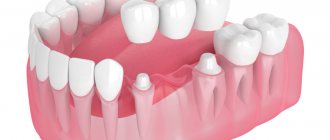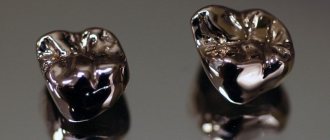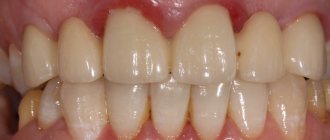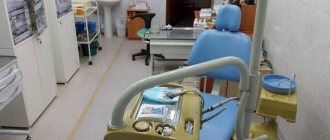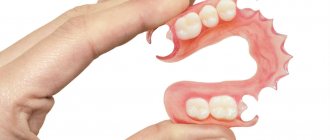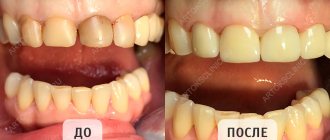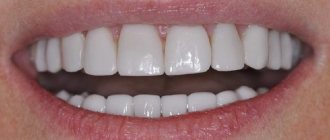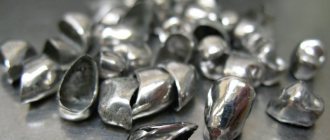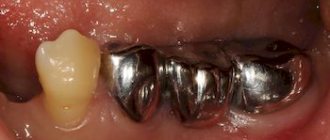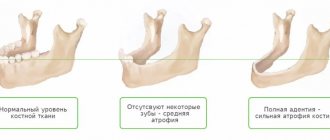Five important questions about how to insert teeth
Before describing technologies for restoring lost teeth, we will briefly answer the most popular questions that interest almost all patients who are faced with the need for prosthetics for the first time.
- Do I need to replace teeth if I have lost them?
Dentists recommend doing this immediately and without fail. Even if the emptiness in the dentition is unnoticeable, do not delay your visit to the clinic. Lack of timely treatment leads to resorption of bone tissue, displacement of the dentition, deterioration of the bite, and can cause changes in the shape of the face and problems with the digestive system. - What teeth can be inserted?
Absolutely everything: natural incisors, canines, molars and premolars can be successfully replaced with dentures. - Does it hurt to put teeth in?
Many patients familiar with the methods of Soviet dentistry are concerned about the question of whether it hurts to insert teeth? We hasten to reassure you: modern methods of anesthesia make the treatment absolutely painless. - How long does it take to insert teeth?
It all depends on the treatment method, the efficiency of the doctors and the dental laboratory. Temporary teeth can be inserted in one visit; permanent dentures require more time. - What is the name of the doctor who inserts teeth?
The doctor who inserts teeth and performs prosthetics is an orthopedic dentist, but treatment and preparation for procedures is usually carried out by a whole team of specialists: dental surgeons, dental therapists, dental technicians.
In order to insert a tooth, do you always need to chase a cheap price?
In our SRC clinics we rarely have special price offers, since we are expert dental clinics with more than 10 years of successful clinical experience. We would like to draw attention to those patients who are trying to get a tooth inserted cheaper, without losing quality: promotions with discounts on implantation are not quite the right way to save on your health, thinking that by doing so you are getting the best and adjusting your costs. The implant is placed for many many years, and everything about it must be of high quality - both the implant itself and its installation.
All modern methods of restoring lost teeth
Just 20 - 30 years ago, metal teeth in the front part of the jaw were not considered something shameful. Moreover, many dreamed of inserting gold teeth, since a golden smile was associated with wealth. Today, dental treatment is technologically advanced, effective and painless, and there are many more ways to insert teeth. Despite the variety of dental services, it is very important for the patient to find good dentistry and a competent specialist who will provide professional assistance. There are hundreds of reviews online where people complain that their teeth were inserted poorly or that the inserted tooth hurts. Unfortunately, such consequences are not uncommon, and their elimination requires repeated treatment and additional costs.
All prosthetic methods are divided into two types: single restoration and complex prosthetics (when you need to replace several lost units or insert complete teeth). Single restoration in most cases is carried out using special inlays (veneers or lumineers) and crowns that are installed on natural teeth or implants. When several teeth are lost or completely edentulous, bridges or removable dentures are used, supported by implants, natural teeth or the oral mucosa. Let's look at these designs in more detail and start with regular dental crowns.
- Metal-ceramic teeth
The crown is based on a metal frame, onto which layers of ceramic are applied under the influence of high temperatures. Such designs are relatively inexpensive and are used for prosthetics of front teeth. Metal tends to oxidize, so over time a bluish outline may form around the gums, which has a bad effect on aesthetics. - Ceramic tooth
These crowns are indistinguishable from natural teeth. Modern ceramics are installed both on the anterior units and on the chewing teeth. The price of ceramic crowns is perhaps their only drawback. The cost of such products is higher than that of similar structures using a metal base. This is why not every patient can afford to have a ceramic tooth inserted. - Zirconium teeth
Today, zirconium dioxide crowns are considered the best of similar designs available on the market. They are as durable as metal crowns, and in aesthetics they are not inferior to ceramic structures. With the help of zirconium crowns, teeth are successfully inserted in any area of the jaw, but when planning to restore lost units, take into account the fairly high cost of such crowns.
Features of inexpensive prosthetics in Moscow
When a person does not have one, several, or needs to insert all teeth, this is really a problem. The patient feels psychological discomfort and cannot chew food properly with his teeth. As a result, an improperly formed bolus of food is the root cause of diseases of the stomach and intestines, and along with this many other health problems. If at least one tooth is missing, the load on the others is not distributed correctly at all. Hence, there is a risk of losing adjacent teeth. As long as you endure the absence of even one tooth, your healthy teeth are subject to excessive stress and wear out significantly. The bite also changes, and facial asymmetry appears. Prosthetics is an opportunity to insert new teeth and restore the functional and aesthetic components of the dentition.
TOP 4 questions that patients ask before implantation and prosthetic structures in Moscow (answered by experts):
1. Is it necessary to replace teeth after losing them? Yes, definitely. The absence of a tooth is the root cause of gradual atrophy of bone tissue, problems with bite and displacement of a number of teeth. These points, as we said above, can lead to problems with the digestive system and deformation of facial proportions. In addition, implantation with bone grafting costs much more than conventional dental restoration without the need to build up solid bone. 2. Does it hurt to insert teeth? No, it doesn't hurt. Modern dentistry offers a whole range of designs, technologies and anesthesia methods, which makes the prosthetic process as comfortable as possible. Even slight discomfort during an anesthesia injection or slight pain (which is quite normal during dental prosthetics) when adapting implants cannot be compared with the complexes and problems that arise in a person who needs to insert one or more teeth. 3. How long will it take to insert new teeth? Everything will depend on the number of lost teeth, the condition of the oral cavity, and the chosen design for prosthetics. During one visit to a dentist in Moscow, it will be possible to insert temporary crowns, so that during the healing of implants and waiting for a permanent prosthesis, a person will feel comfortable, be able to smile, talk, and chew food with the inserted crowns. 4. Is it expensive to get teeth inserted in Moscow today? Modern developments in implantology and prosthetics make it possible to choose the optimal inexpensive solution for people with both an impressive (price - about 300 thousand rubles) and a limited budget (price - no more than 50,000 rubles). In addition, dentists regularly launch promotional prices, special offers, offer favorable payment terms, installments, which allows inexpensive teeth insertion without excessive costs.
Which crown to choose
Most of all, patients are interested in the cost of crowns and their aesthetics. Of course, you can choose a prosthesis yourself, focusing on your financial capabilities and ideas about beauty. But it is better if a doctor does this. Before starting the restoration of the dentition, the dentist evaluates the condition of the root system, gums, mucous membrane, tissues of the root part and cervical area. When choosing a prosthetic method, it is important to exclude all contraindications. They differ depending on the method of tooth restoration. The most serious are diseases of the immune system, oncology, uncompensated diabetes mellitus and periodontal inflammation. The doctor’s task is to choose the safest prosthetic option for the patient and the one that best suits the clinical picture.
Indications and contraindications for the installation of porcelain crowns
| Indications: | Contraindications: |
|
|
Implantation: indications and benefits
Implantation is the most advanced dental technique that allows you to insert a tooth in place of an extracted one.
- Implants eliminate dental defects of any location and extent.
- People quickly get used to the implants. There is no discomfort, no sensation of the presence of a foreign body in the oral cavity, no problems with chewing food.
- Before implantation, there is no need to grind and depulp adjacent teeth; they remain healthy.
- Implants do not need to be changed or adjusted. With proper implantation and personal hygiene, artificial roots can last a lifetime.
- Even under increased loads, there is no risk of implants falling out or loosening.
Prices for complete prosthetics
| Name | Price, rub) |
| Complete jaw prosthetics on 4 Osstem implants (South Korea) with a fixed plastic prosthesis | RUB 225,000 |
| Complete jaw prosthetics on 6 Osstem implants (South Korea) with a fixed plastic prosthesis | 275,000 rub. |
| Promotion! Jaw prosthetics on 4 Straumann (Switzerland) or Nobel (USA/Sweden) implants with a fixed plastic prosthesis | 260,000 rub. |
| Promotion! Jaw prosthetics on 6 Straumann (Switzerland) or Nobel (USA/Sweden) implants with a fixed plastic prosthesis | 320,000 rub. |
Removable prosthetics
At the Family Dentistry clinic, treatment of patients with complete absence of teeth in the upper or lower jaw is carried out only by the method of permanent prosthetics on implants. The main disadvantage of removable dentures is atrophy of the jaw bone. The longer you wear them, the more bone tissue decreases. Subsequently, when the patient decides to install a fixed prosthesis, preliminary bone grafting will be required. If you decide to wear a removable denture, we can only help you find a good dental clinic that provides removable denture services.
1 Acrylic prosthesis
2 Acry Free dentures
3 Nylon prosthesis
A classic option for restoring the integrity of the dentition with complete edentia. In demand due to its low price. But at the same time it is the most inconvenient type of complete removable denture. Pros:
- low price;
- fast production times;
- easy to repair, adaptable (increases service life).
Minuses:
- provokes injury and inflammation of the gums due to constant stress;
- takes up a lot of space in the mouth (more voluminous than its counterparts), it is difficult for the patient to get used to wearing a plastic prosthesis;
- may cause an allergic reaction as a result of the free monomer contained in acrylic reacting with saliva;
- the artificial gum is opaque, the acrylic prosthesis does not look natural;
- Acrylic absorbs food coloring pigments and requires careful care.
Acry Free thermoplastic plate prosthesis is the most durable, aesthetic and long-term solution in complete removable prosthetics. Pros:
- The Akri Free prosthesis is thin and fits more tightly to the tissues of the prosthetic bed (the patient gets used to wearing it faster);
- does not cause allergies, as it does not contain methyl methacrylate;
- thanks to the aesthetic artificial gum, it is practically indistinguishable from your own teeth;
- has no pores (unlike acrylic and nylon), does not absorb food pigments, does not cause bad breath, and is less demanding in care;
- easy and inexpensive to repair.
Minuses:
- fragile, does not always withstand increased chewing loads and breaks;
- the price is twice as high as for an acrylic prosthesis.
Made from dental nylon, which is lightweight and elastic. Typically used as a temporary solution. Pros:
- takes up less space in the mouth, weighs less, so it is comfortable to wear;
- the prosthesis is flexible, easy to remove and put on, and will not break if accidentally dropped on the floor;
- The orthopedic design is practically invisible, as it is made of translucent material with a shade close to the color of the gums.
- does not cause allergic reactions like acrylic prosthesis.
Minuses:
- due to flexibility, it does not distribute the chewing load over the entire mucosa and leads to rapid atrophy of the alveolar ridge;
- nylon cannot be polished; after 2 years, plaque and pigments accumulate on it, and its attractiveness is lost;
- Eating hot food/drinks increases the elasticity of the prosthesis; frequent adjustments are required;
- rubs the gum, causing its atrophy (abrasions and bedsores form under the denture);
- repair of a nylon removable denture is very complex and expensive, and relining in the oral cavity is impossible;
- absorbs odors, after 1-2 years it begins to smell unpleasant.
How is an implant inserted?
The essence of this technique is to implant a titanium root into the jaw, on which a crown is subsequently installed. On average, implant healing takes from 2 to 6 months. During this time, a temporary orthopedic structure is installed for the patient’s convenience.
There are protocols for immediate implantation. Modern structures can be inserted after tooth extraction and immediately loaded with a prosthesis. Many patients are interested in whether it is painful to insert a dental implant. In fact, implants are installed quite quickly (15 - 20 minutes per tooth), and an injection of anesthesia allows you not to feel pain. If you have severe dental phobia, the doctor will suggest inserting teeth under anesthesia or sedation.
Making porcelain crowns
The production of porcelain crowns requires the presence of expensive equipment and experienced specialists on the staff of a clinic or dental laboratory. Today, two methods are used to produce such crowns - layer-by-layer application of porcelain mass and injection molding technology. The second method is considered more modern (as it provides the finished structure with greater strength) and is used in most dental laboratories. The production of a porcelain crown takes place in several stages.
Stage 1 - preparatory
Preparation of teeth for a porcelain crown and selection of color for the future prosthesis.
Stage 2 - taking an impression
The doctor takes impressions of the teeth, which are then sent to a dental laboratory.
Stage 3 - matrix production
Thin platinum foil is used as a mold for the future dental crown, which is placed on the model and filled with porcelain mass.
Stage 4 - firing
The crown goes through several stages of processing under the influence of high temperatures.
Stage 5 - product processing
The dental technician makes adjustments to the structure so that its shape and surface perfectly match the patient’s teeth. At the final stage, the finished structure is painted and glazed.
Methods for restoring anterior and chewing teeth
In the absence of teeth, the best way would be implantation, but if you have contraindications to this procedure, there are alternative options - installing a bridge with grinding of adjacent elements or a soft removable denture with clasps.
The same designs are used for chewing teeth: crowns, implants, removable and bridge dentures. The peculiarity of chewing teeth is that they are subject to heavy loads, so especially strong crowns made of zirconium dioxide or metal-ceramics are usually installed in this section.
If you need to insert 1 tooth
To restore one badly damaged tooth, an orthopedist may suggest a crown. If a tooth is missing, a bridge or implantation is required.
If you need to insert a tooth in place of a removed one
After removing a tooth, it is advisable to insert it within 1 – 2 months, since after some time the processes mentioned above begin to occur. If you want to completely restore the functionality, aesthetics, and anatomy of your tooth, dental implants are your best choice.
If you need to insert three teeth
In modern dentistry, to replace three lost teeth (in a row), a bridge prosthesis on implants is usually installed. If there is a limited budget or there are contraindications to implantation, the prosthesis is placed on the ground adjacent teeth.
If you need to completely insert teeth
Teeth restoration in cases of complete edentia is carried out using removable dentures. The best option is considered to be designs supported by implants, which guarantee the patient a good quality of life. In other cases, removable dentures are used with support on the mucous membrane and soft tissues.
Which implantation method is best for restoring all teeth?
Mini-implantation can definitely not be considered as an effective solution in case of complete absence of teeth. There are two protocols left - classic full two-stage implantation with delayed loading and one-stage implantation with immediate loading. But in case of complete absence of all teeth, again, not every method is suitable.
With the classical approach, a permanent prosthesis can be placed only after the implants have completely fused with the bone tissue, that is, the process of osseointegration has been successfully completed. This method is only relevant for situations where there is sufficient jaw bone tissue. Usually, if it is not enough, then extension is carried out. But if all teeth are missing, such an operation will not only be very labor-intensive, but also very expensive. The bone will have to be replanted in several procedures; a large number of implants in the absence of teeth will also require several installation operations. Abutments and a permanent prosthesis are not placed immediately - only after the implants become one with the bone, that is, they grow together. This means that we will have to return to removable prosthetics again. Thus, complete rehabilitation takes a year at best, but in reality – 1.5-2 years.
Is it possible to insert teeth without grinding down the adjacent ones?
Before installing classic dentures with fixation on natural teeth, preparation is required. Without grinding, restorative procedures are carried out using plastic structures with special clasp hooks that clasp the neck of a healthy tooth and thus hold the prosthesis in the oral cavity. The production and installation of such prostheses occurs much faster than in the case of overlay prostheses on implants, but you should not count on recovery in one day. If we are not talking about temporary prostheses, the creation of structures, fittings, and corrections can take several weeks.
What determines the final price of prosthetics in Moscow?
There are three key factors on which the price of dental prosthetics in Moscow depends:
- Selected prosthetic technology. Inserting an inexpensive removable denture will be most profitable. But here it is worth taking into account durability and guarantees. Implant manufacturers provide a lifetime warranty on their designs. An inexpensive implant installed will provide decent smile aesthetics, and most importantly, the chewing load will be optimally distributed.
- Prosthetic material. It is quite inexpensive to insert prostheses made of metal, plastic and nylon in Moscow. But such savings on material are impractical when it comes to the smile zone. To ensure optimal aesthetics, it is better to insert teeth made of porcelain, ceramic or a premium material - zirconium.
- Preparation for prosthetics. Before any prosthetics and implantation, dental treatment is prescribed. Caries, pulpitis, periodontitis are comprehensively treated, gums are strengthened, complete sanitation of the oral cavity occurs, and hard and soft plaque is removed. The price of such treatment in Moscow is paid additionally. Also, a certain budget will need to be allocated for bone grafting, which is needed for a stable position of the implant in the bone.
- Scope of work. Of course, the more teeth you need to insert, the higher the final price of prosthetics and implantation. If you have lost one tooth, it is much easier and cheaper to replace it than to restore and replace adjacent teeth after five years, which will lose their integrity due to overload.
Treatment prices: which teeth are better to insert on a limited budget
The cost of restoring one or more teeth depends on the treatment method and your budget. The most expensive treatment involves the use of implants. The cheapest thing is dental crowns.
| Insert teeth under anesthesia | An anesthesia injection costs on average 500 - 800 rubles. Treatment under general anesthesia - from 4,000 rubles (30 minutes). Sedation will cost from 1,500 rubles for half an hour. |
| Insert ceramic tooth | From 15 thousand rubles depending on the level of the clinic |
| Insert metal ceramics | From 9 thousand rubles. Depends on the metal alloy used |
| Insert a dental implant | 15 - 25 thousand for installing a budget brand of implants. 35 -50 thousand for a premium implant |
| Insert teeth completely | A removable denture on implants for one jaw costs on average from 120 to 250 thousand rubles (depending on the number of implanted implants and their brand). A regular removable denture will cost 25-50 thousand for one jaw |
| Insert zirconium teeth | From 25 thousand rubles depending on the level of the clinic. |
In just 1 day you can achieve your goal and completely change your life.
As the name implies, with one-stage implantation with immediate loading, the entire prosthesis will be fixed immediately, that is, immediately, without waiting for the implants to fully engraft. But, of course, subject to certain requirements: when choosing implant models that can actually be loaded with a prosthesis (manufacturers write about this in the review of their products), with their correct positioning in the jawbone, with good primary stability, and also when installing a certain type of prosthesis . In particular, during the manufacture of which a metal base is created that will stabilize the installed implants, that is, keep them stationary even when you begin to actively use new teeth.
Doctors at the Smile-at-Once center are followers of the Immediate Load Implantation school (which translates from English as “implantation with immediate load”) and were among the first in Russia to use this technique in their practice. The clinic’s specialists have certificates from the International Foundation of Implantologists, Nobel, Straumann, Oneway Biomed, and are also accredited masters of immediate loading with the right to train Russian colleagues.
Undoubtedly, implantation with immediate loading in the absence of teeth is more advantageous from all sides: bone grafting is not needed (even in a complex upper jaw), there is no need to return to removable dentures, and rehabilitation is faster.
In fact, you get new teeth in 1 day, with a lifetime guarantee on treatment. One-stage implantation with immediate loading
| SIGN OF COMPARISON IN THE ABSENCE OF ALL TEETH | COMPLETE TWO-STAGE IMPLANTATION WITH DELAYED LOADING | COMPLETE ONE-STAGE IMPLANTATION WITH IMMEDIATE LOADING |
| The cost of implantation and prosthetics (in rubles, the price is “turnkey”) | 900,000 for 2 jaws on implants | from 200,000 for 1 jaw on implants (depending on the protocol and brand of implants) |
| Duration of treatment | from 2-4 to 18 months | no more than 7 days |
| Number of visits to the doctor | 10-25 | 3-5 |
| Number of hours spent with a doctor | from 7 to 30 hours | to 10 |
Where to get teeth inserted in Moscow?
There are thousands of clinics in the capital, most of which offer almost all types of dental restoration (crowns, implants, removable and bridge dentures). Choosing a clinic is quite difficult, so we advise you to pay attention to important nuances. Study the clinic’s website: it should contain detailed information about specialists, treatment methods and technologies, as well as relevant diplomas and certificates. Read patient reviews about dentistry on third-party resources. Directly during the consultation, do not be afraid to ask questions and find out details. A good doctor will always give comprehensive information and offer various treatment options. The search engine on our website will help you find reliable dentistry.
How to choose a clinic to insert new teeth inexpensively in Moscow?
Experts give 5 ready-made tips for choosing a good clinic in Moscow, where they will perform high-quality prosthetics and implantation at an affordable price:
- Pay attention to prices. There is always a “golden mean” of prosthetics that is worth starting from. For example, if an implant costs about 50 thousand rubles in Moscow, then in another clinic its price may be 20 thousand. Most likely, there is a marketing ploy here, or the patient is simply not provided with accurate information about the price, but will be told it after he decides to have his jaw inserted. A high-quality dental prosthesis, implant and doctor’s work cannot be cheap. Always compare prices from different dentists with the market average. Be interested in prosthetic materials and technologies, which have different prices in different clinics. With a clearly defined goal, you will always find the optimal inexpensive solution.
- Big savings are always questionable. Tempted by very low prices at a Moscow clinic, the patient may pay with his own health. There is a high risk that if you make mistakes during prosthetics and dental implantation, you will have to pay several times more than the final price to redo poorly done work.
- Schedule an initial consultation with your dentist. As a rule, it is free or provided inexpensively by Moscow doctors. A personal visit to the clinic will allow you to get acquainted with the dental center, technologies, prices, personally evaluate the professionalism and experience of the doctor, ask questions, find out about discounts on dental prosthetics, meet a doctor who can insert strong, beautiful and durable crowns, etc. .
- Be interested in different prosthetic technologies. Patients with a large number of missing teeth are offered two options for inserting new teeth. The first option is to insert a fixed denture, and the second is to insert an inexpensive removable jaw. From at least five technologies, you can choose the most suitable one in terms of price and quality. For example, insert inexpensive single dentures, fixed bridges, and also perform prosthetics on inexpensive implants.
- Agreement conditions. At the stage of choosing a clinic and a doctor, always be interested in the terms and conditions that must be specified in the agreement between the patient and the clinic. In this way, you will protect yourself from missed deadlines, price increases and other undesirable aspects of dental prosthetics.
What types of dentures are there for damaged teeth?
It often happens that the crown part of the tooth begins to collapse, but the root is completely healthy and sits firmly in the gum. In such cases, dentists do not recommend removal, because the root can be preserved and the crown part can be replaced with prosthetics - this is a more gentle and beneficial method for the patient to restore the defect. What dentures are available for such cases? There are several types of so-called microprostheses that will help restore the integrity of the dental crown:
- Tabs.
Simply put, these are large fillings made of ceramic or metal alloys that are made in a laboratory. The inlays exactly repeat the shape of the destroyed part of the crown and can serve as both an independent microprosthesis (restorative inlays) and a support for an artificial crown (stump). - Crowns.
The crown is the part of the tooth that we usually see and on which both the beauty of a smile and the quality of chewing food depend. Dentists install artificial crowns that cover the damaged tooth and completely cover the defects. They are made from metal-free ceramics (excellent aesthetics, good strength), metal ceramics (good strength and aesthetics) and plastic (suitable only for making temporary crowns, because such material is not very durable and stains over time). - Veneers.
For teeth in the “smile zone,” it is possible to install not entire crowns, but thin ceramic overlays on the front surfaces – veneers. They are installed if sufficient volume of the rear wall has been preserved and the microprosthesis can be securely fixed. Veneers are made from ceramics, and recently there are also designs made from zirconium dioxide. The simplest and most inexpensive option is composite veneers, formed from filling material directly on the patient’s teeth.
Orthopedic dentist at the 32 Dent clinic Veronika Aleksandrovna Ivantsova: “Microprostheses are good because they can restore both small defects (mainly veneers and lumineers) and seriously damaged teeth. We recommend our patients to fight for their own teeth to the last and, if possible, to preserve the dental unit - in no case to remove it.”
Which dentures are best to install: choose by cost
The most affordable microprostheses are inlays - they cost from 18,000 rubles. However, it is not always possible to get by with just one tab, so it is advisable for the patient to make a choice, guided not only by savings, but also by the advice of his doctor.
Veneers with lumineers will cost approximately the same - about 20-35 thousand rubles. Crowns differ slightly in price depending on the material: metal-free ceramics will cost about the same as a veneer, metal ceramics will cost 9-17 thousand rubles. Here you should choose according to the degree of destruction of dental tissues: if the defects are minor, you can get by with installing veneers. But in the case where the crown part of the tooth is seriously damaged, the installation of an artificial crown will be required.
If you have a problem similar to that described in this article, be sure to contact our specialists. Don't diagnose yourself!
Why you should call us now:
- We will answer all your questions in 3 minutes
- Free consultation
- The average work experience of doctors is 12 years
- Convenient location of clinics
Single contact phone number: +7
Make an appointment
Reasons for missing teeth
1-2% of the population has a genetic disorder in which teeth are initially absent or their number is abnormally small. In the vast majority of cases, the absence of lower or upper teeth is a consequence of illness or mechanical damage. Doctors at the clinic name the main reasons:
- Untreated caries or pulpitis. Tooth tissues are destroyed, in advanced cases, inflammatory processes in the gums begin, and the bone structure changes. Our dentists try to preserve every unit. But, if the process is already irreversible, then it is necessary to remove one tooth or several.
- Inflammatory processes in periodontal tissues lead to the fact that the ligament cannot hold the tooth in the socket. The crown becomes loose, destructive phenomena progress, and the gums and bone are destroyed.
- Injuries. The complete absence of teeth or partial adentia is caused by dislocations, bruises, fractures of the tooth crown or root, and other damage resulting from mechanical impact.
Sometimes teeth can be lost after suffering from somatic diseases: oncological, endocrine, and others that weaken the immune system and affect the structure of tissues.
